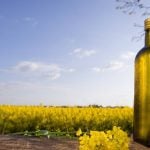EDMONTON – Fusarium headblight sparked an interest in double nozzles, leaving farmers with key questions about sprayer technology.
At the FarmTech conference this winter, Tom Wolf, a research scientist with Agriculture Canada in Saskatoon, talked about sprayer issues including single and double nozzles, the direction nozzles face, droplet size and how water volume affects spray efficacy.
Wolf said the interest in double nozzles started with the problem of fusarium head blight in the Red River Valley.
“We’re talking about a disease that affects the wheat head and wheat heads are vertical targets. They’re difficult to hit with a conventional vertical spray.
Read Also

VIDEO: Green Lightning and Nytro Ag win sustainability innovation award
Nytro Ag Corp and Green Lightning recieved an innovation award at Ag in Motion 2025 for the Green Lightning Nitrogen Machine, which converts atmospheric nitrogen into a plant-usable form.
“The idea forwarded by North Dakota State was, if we use a double nozzle, we can cover the leading edge and trailing edge of that head with the leading and trailing edge of a double nozzle.”
Wolf said the problem with double nozzles was the operator had to go slow. The spray forward and backward had to be coming out at the same speed.
Also limiting double nozzle use was the need for low boom height and low wind speed to prevent drift.
Wolf said when spraying, all droplets come out of the nozzle at about 70 km-h. By the time they hit the target, the large droplets have slowed down to 30 km-h and the small droplets have slowed to about seven km/h.
“They’re going very slowly. There’s not much we can do about that. It’s like trying to throw a feather. The only way we can accelerate a small droplet is if we blow it down with air,” said Wolf.
“Large drops go in the direction you spray them. If you’re spraying a droplet down at 30 km-h and travelling forward at 10 km-h, that droplet carries a combination of the downward and forward momentum. The faster you go, the more forward that droplet is going to go.”
Small drops, because they don’t have much inertia, go whichever way the wind blows. It doesn’t matter whether that small drop is pointed forward or backward, or whether you go fast or slow. The air prevents the small droplet from retaining its initial trajectory, making it difficult to control.
Wolf said all objects, including leaves, have air flow around them. A large drop can penetrate that air flow, but a small drop can miss the target.
“Large targets like large droplets. They don’t like small droplets. With small targets, like cotyledon leaves or stems, there’s also a change in direction of air, but it’s not nearly as severe,” he said.
“The small droplet will change direction but will still impact. The large droplet, by virtue of its relatively low abundance and the fact that its target is so small, it’s very unlikely to hit that small target.”
Wolf said because spray targets have stems, big leaves, small leaves, horizontal leaves and vertical leaves, a producer needs a variety of droplet sizes to cover all the bases.
“When we go to a low-drift nozzle, we don’t eliminate small drops. We just reduce the relative proportion. When we have a conventional nozzle, we also have large drops, just not very many and not very large. With a low-drift nozzle, we have more and larger large drops, but we still have a variety of droplet sizes in that spray.”
Wolf said most of this work was done with the nozzle about 50 centimetres above the target.
“All these dynamics happen in the first 50 cm of travel. It gets worse the more they travel and it’s worse when you go fast. The faster you go, the more air pushes the small drops out of the spray plume and the sooner they’re liberated from their downward movement. It happens quickly.”
He said twin-cap nozzles and others like it allow people to spray forward and backward, and also allow them to easily use different nozzles. In a laboratory track room, Wolf measured spray deposition with dyes using artificial targets for horizontal and vertical spraying and for forward and backward.
“When we went to a single, conventional flat-fan nozzle, we found about two-thirds of the spray deposited on the front of the head and one-third on the back of the head. With a single air-induced nozzle, we had a similar result,” he said.
“With a double nozzle, with a 60-degree from vertical separation, we had good deposition on the front and significantly improved deposition on the back. Pretty uniform deposition overall. So the theory seemed to work.
“Then we took two air-induced bubble jets, went forward and backward, and found better deposition than with the fine spray. That was because we were able to maintain that forward and backward trajectory because the spray was coarser and the droplets were bigger.”
When he took the same setup and accelerated the application rate, Wolf found a significant increase in the deposition from the front nozzle, but no real change with deposition from the back nozzle, which he found encouraging.
“We took this to the field with a fungicide on three site-years in Saskatchewan with fusarium head blight and found the double nozzle had no effect on the efficacy of the fungicide. So even though we had better deposition, we had no improvement in performance.”
One of the reasons there may not have been an improvement may have been that the fungicide is only rated for suppression of the disease, not control of it.
Wolf also took the setup into the field with Horizon, on oats, to see if he would be able to get a better kill using a double nozzle. The answer was no. He could not demonstrate that.
With lab results that said it was a good idea but field results that said no benefit, Wolf was puzzled.
“The biggest problem with going to double nozzles is, you have to use half the flow rate from each nozzle, and that tends to make a fine spray. I would not recommend that. But if you go to two coarser nozzles, I think there’s a potential advantage, but I haven’t realized that yet in a field trial.”
Then he looked at the double nozzle angle and wondered if 60 degrees would do the job as well as 120.
“We used the same setup, with two travel speeds- about five and 10 mph (eight to 16 km-h) – with a fine and coarse spray. With the fine spray double nozzle, the faster travel speed performed slightly better. The coarse spray, particularly with the slow speed, performed better,” he said.
“When separated by 60 degrees, we had not a big difference with the fine spray. But with the coarse spray, we saw that difference. The change in trajectory we gave that nozzle could be realized only when we had a coarse spray. If we change the angle on the fine spray, it’s not going to make a lot of difference because it’s going to go whichever way the wind goes.”
Wolf said typically, the front nozzle contributed the majority of the dose, with the back nozzle contribution half to a third of the front nozzle. Twin nozzles more than doubled spray deposits and the front nozzle was more important than the rear nozzle.
“Even the single nozzle did some good work on the back of the target. Coarse sprays and high travel speed increased deposition. Wider angles are a good idea.”
Wolf said some farmers might try a fine nozzle in the front and a coarse nozzle in the back, but he advised against it.
“We had the highest deposits with two coarse nozzles in the double nozzle body. You don’t need the fine spray, so why bother?”
He said the issue of facing spray nozzles forward or back has been the subject of debate.
“In all the work we’ve done, with single or double nozzles, forward and backward angles, I have two different sets of answers. The first one is, on a horizontal target, like a broadleaf weed, we have not seen any effects. We get the same amount of spray on a horizontal target, no matter how we angle that spray,” he said. “When we go to a vertical target, like a stem or wheat head, we do see an effect.”
Wolf’s trials included nozzle orientations 60 degree and 30 degree backward, vertical, then 30 degree and 60 degree forward.
“With a medium spray quality nozzle, there wasn’t much difference. With a faster travel speed and a coarser nozzle, forward angling takes a bit of an advantage over backward angling.
“With an air bubble jet, it had the least performance on the vertical and the best with 60 degree forward. But the 60 backwards wasn’t that bad, either. At a higher speed, the forward angle performed the best.”
Based on these conclusions, to get a vertical target, a forward angle is probably more effective. With a horizontal target, he said it won’t make much difference.
Wolf said he’s an advocate of coarse nozzle spraying, because it’s good for the agriculture industry.
Canada uses 45 million kilograms of pesticides per year. If 80 percent is applied by sprays and 1.7 percent of that is lost to the atmosphere, that means 600,000 kg of lost pesticide every year.
“There’s no such thing as a pesticide-free lake in the world,” he said. “The point is, we have to use pesticides responsibly because we’re being watched. So I’m an advocate of coarse spraying because it reduces drift. I’ve seen air-induced nozzles reduce drift by 95 percent. They’re terrific. I offer these four rules for making them work:”
- Spend time selecting nozzles and listen to an expert. Not every nozzle is right for your needs. For example, Group 1 grass killers do not like coarse sprays.
- Air-induced nozzles require higher pressures to work properly. Stay within the range recommended. Higher pressures do not reduce the drift control these nozzles offer.
- Keep water volume appropriate.
- Ensure sufficient overlap. Because coarse droplets go where you point them, a 30 percent overlap is not sufficient. More overlap is needed to ensure complete uniformity of droplets underneath the boom. Maybe using a wider angle nozzle and elevating the boom slightly could help.
“I know there are advantages to using less water. It makes you more efficient. But there are also disadvantages. You will get more drift, because low water volumes are associated with finer sprays. You will get less consistent control. Less water volume gives you less canopy penetration, because it’s difficult to get droplets through a dense canopy,” he said.
Wolf agreed there are environment conditions, crop agronomic conditions, or staging issues, where herbicide rates can be reduced. But ultimately, that weed must get a certain dose in order to die.
“Dose is more important than coverage. You have to get the recommended amount of product on the target. Getting more droplets on the target is only a slight advantage to you if you don’t get the dose on. More small droplets does not mean you have more dose.”
With Horizon for oat control, Wolf sprayed with a medium, coarse and very coarse spray, at four gallons per acre. At medium and coarse he had acceptable control, but with a very coarse spray he had a loss of control.
“When you go to a low water volume, you have to be careful. When we upped the water volume to eight gallons per acre, we were able to mitigate that loss of control. If you’re going to use a low drift spray and you want to go coarse, you’re going to have to have some water there.”
With Everest and soil activity, in two out of three years that Wolf did trials he had rain a week or two following application.
“When you have soil activity, it just doesn’t matter. It gets washed into the soil and you’re good to go.”
He said low drift sprays are an important tool, but they must be used carefully.
“If I was going to go with grassy herbicides I would use higher volumes, because they allow us to use coarser sprays that give us better coverage. I would not use (nozzles) coarser than a medium at low water volumes – three to four gallons per acre,” he said.
“At eight gallons or higher, you can use up to coarse sprays, but with Group 1 products, I would not use very coarse sprays.”
“Stubble is a terrific interceptor of spray. Not only is it a vertical target that likes to intercept forward moving droplets, it’s usually surrounded by dead leaf tissue. It’s an efficient collector of spray,” said Wolf. “One of the best ways to get through that is with a coarser spray, a slower travel speed and vertically orientated nozzles.”
Wolf said farmers will often change nozzles for different flow rate requirements. They might have a preseed burnoff nozzle for three gallons per acre, an in-crop for seven gallons and a fungicide or desiccation nozzle for 10 or 15 gallons.
“But I doubt very much for every flow rate, farmers will have three nozzles depending on the canopy situation. You’d go crazy changing nozzles all the time.”














